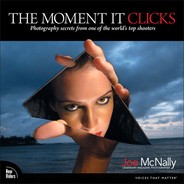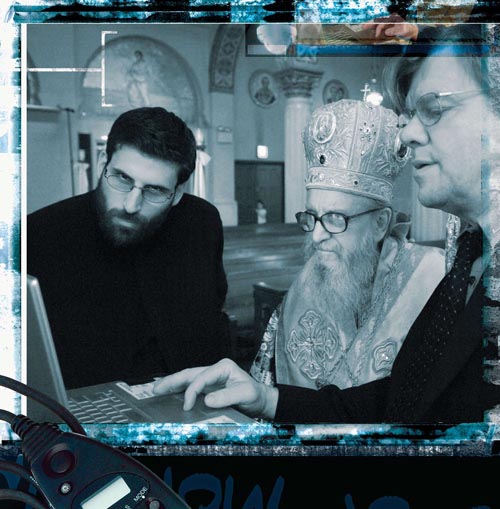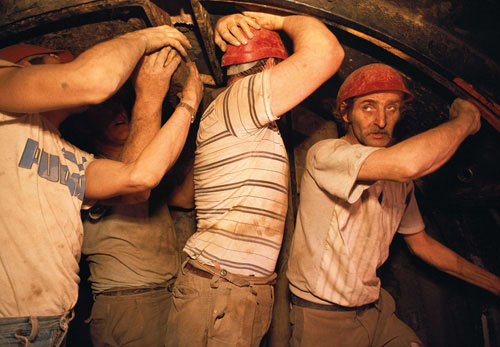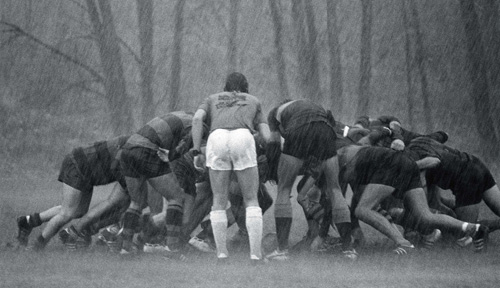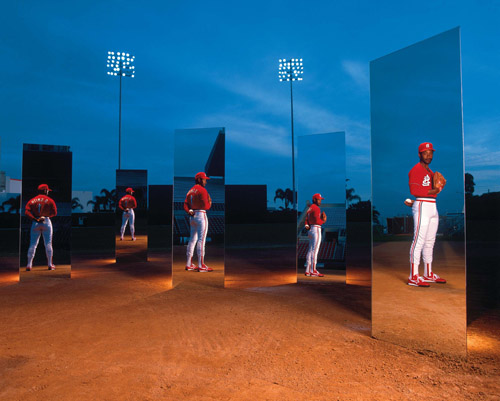Sometimes, you just gotta wing it. Got a job to shoot a photo portfolio of the overlarge freshmen NCAA hoopsters for Sports Illustrated. Started conjuring. One kid, Brandan Wright, had a wingspan of 7′4″. Okay, Batman comes to mind. Magazine liked the wings idea, but wanted them white. Cool...just switched screens in my head to X-Men 3.
“Magazine liked the wings idea, but wanted them white. Cool...now try finding wings for somebody six-eleven with arms that don’t stop. It ain’t easy.”
Now try finding wings for somebody six-eleven with arms that don’t stop. It ain’t easy. My studio manager Lynn, who is a magical producer, started making phone calls and after a lot of dry wells, finally found the wing makers to the film and television industry, a small outfit in L.A. (where else?) called...Mother Plucker! I kid you not.
Money is a huge concern in any production, and these wings cost $3,400, last minute drop shipped straight to North Carolina. Steve Fine, DOP[1] at SI, called. “Can’t you go to a Halloween shop?” he asked. I reminded him of the size of our subject. Got the go ahead.
[1] DOP is Director of Photography. He’s the guy that controls my air supply—he assigns the story, has control over the overall direction of the photography, and is the main tap. Everything flows from him.
(Steve Fine and Jimmy Colton are currently the best one-two punch in picture editing, by the way. Steve has the calculus of sports in his head. He knows that if LSU beats Auburn this Saturday, he has to move three photogs on January 3rd to New Orleans for the Sugar Bowl ’cause LSU will go up against Florida State.
He doesn’t even have to look at a schedule. Jimmy has always been a voice of reason and counsel to young photographers, an open door, and a shelter from the storm. Together, they are formidable and fight the good fight.)
So we got the wings at ll:30 in the morning for a 1:00 p.m. photo shoot. I was being allowed 30 precious minutes of this very important 18-year-old’s life, no more. I had exactly an hour and a half to figure out how to hang these wings, stage and light the photo, and come up with at least two different solutions.
Brandan Wright
“It’s too bad ring light’s gotten a bad rap, because when used properly and judiciously, it is a pretty snappy light that edges out your subject with the clean and definitive efficiency of a drill press.”
The ring light[1] needs to be used...carefully. It has gotten a bit of a bad rap, probably from overuse in those downtown magazines with catchy names that usually last for about two issues and run page after page of disaffected, outlandishly dressed young people, apparently high on some form of illegal substance, staring vacantly at the camera with a circular highlight in their overlarge pupils.
[1] Ring Light: A circular light source that wraps around the barrel of the lens. Produces a hard, shadowless light. Very popular with fashion photogs.
It’s too bad, because when used properly and judiciously, it is a pretty snappy light that edges out your subject with the clean and definitive efficiency of a drill press. Throw in a bit of hair, makeup, styling, a fishnet cat suit, a killer look, and oh my! Have to be careful tipping it around too much though, ‘cause at an unfortunate angle it produces shadows that can turn even a shimmering sex goddess into something that dropped out of the ugly tree.
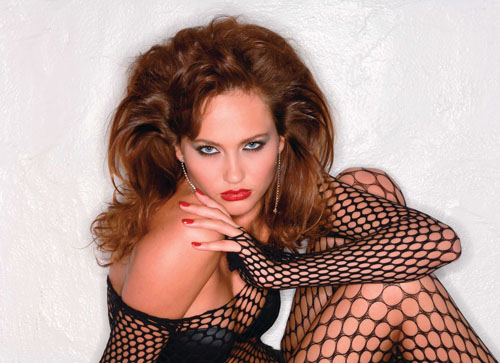
I was sent to the Southwest to photograph a Tyrannosaurus head for the cover of Discover.
Now this T. rex head turned out to be a realistic-looking, eight-foot hunk of polyurethane that was in the sculptor’s garage, gathering dust. This is a typical assignment for me. Go make a national magazine cover out of a grime-laden piece of plastic.
We cleaned it, loaded it into a pickup, and trucked it out into the desert area, which was actually part of a national park. I rented a heavy-duty crank lift and a chainsaw, and got some rope and lumber. I’m an overgrown adolescent who saw Jurassic Park too many times and I wanted this puppy coming out of the trees, just like on the big screen. We found a tree, made sure no park rangers were around, chainsawed the $#!& out of it, and stuffed the lift in there. Then we took some of the branches and A-clamped them to light stands, lit the whole thing up Hollywood-style (shot at dusk), and got outta Dodge.
“This is a typical assignment for me: Go make a national magazine cover out of a grime-laden piece of plastic.”
Tech Note: It was my first shoot with the Nikon D2X. Nikon had squirreled me away an early prototype. I’d been shooting with the D2H, and with my first few frames from the D2X, I saw the colors pop and knew, digitally speaking, we weren’t in Kansas anymore.
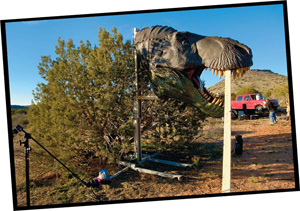

I get there early. What can I say? I was raised Irish Catholic, so I feel guilty about stuff I’m not even responsible for. If I’m not in the parking lot two to three hours ahead of my appointment or assignment, I feel guilty. If I’m ever outright late, I feel like I gotta recite a frikkin’ Novena.
This has benefits as an assignment shooter. You get the best parking spots at events, for instance. The security guys can’t believe you just showed up at 6:00 a.m. for an event that evening, but no matter. So many people think I’m odd, I’ve given up worrying about it.
“Turned around, and there was Jason Robards rehearsing his lines. Stuff like this happens in New York when you’re there early.”
Even for local jobs, it’s good to get there early. In New York, I was assigned to shoot a bunch of actors doing public readings in an effort to save some of the older, historic Broadway theaters. It was cool. Some very famous theater people gathered and gave stirring public readings to save the old playhouses.
Didn’t work, of course. Money was at stake, and when that goes down, even having Lauren Bacall on your side don’t matter. The furry creative types are swell, but it was like sending shovel-toting peasants up against the Vikings.
The theaters went down, but the readings were great to shoot. It was like having a play for free right there in the street. I got there way early and ducked into a coffee shop, eternal refuge and impromptu office of the freelancer. Turned around, and there was Jason Robards rehearsing his lines.
You have to choose your strategies here. Years ago, I was assigned to cover the circus-like trial of Sid Vicious in New York City, which basically meant hanging around the courthouse all day to no photographic avail whatsoever. I mean, there were no pictures except for some of Sid’s punk friends who were hanging around as a show of support for their crackpot, unwashed, misogynist leader in spirit and kind. So I followed a group of these into the greasy spoon of the courthouse cafeteria, sat at the counter across from them, and ordered coffee. After a moment or two, I quietly snapped a frame with my Leica. This produced a baleful glare. Another snap.
Another glare. Another snap, and this time a snarl: “If you fookin’ take another photo of me, I’ll fookin’ kill ya!” At this point, I’m in for a penny, in for a pound, and I reach down to my camera bag and pull out a motor-driven F2 with a Vivitar and start pounding flash pictures. He came right over the counter at me.
There are, perhaps, better ways to break the ice. Like walk right up to your subject and ask.
Mr. Robards couldn’t have been more gracious, or more wonderfully oblivious to being photographed.
Stuff like this happens in New York when you’re there early.
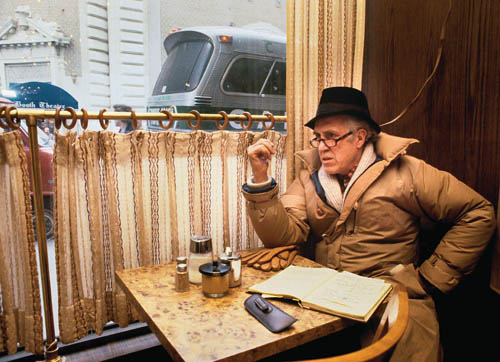
Jason Robards
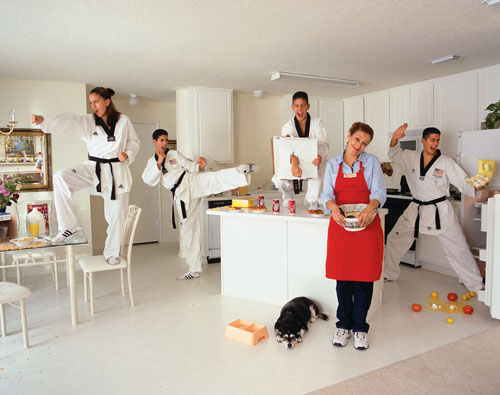
I was such a rube when I came to New York that it really became a classic case of the lord looking after a fool. I knew so little, I didn’t know that young photographers, fresh out of school with no experience, weren’t really supposed to call the photo editor of People magazine.
John Dominis, legendary Life shooter, was the editor at the time. I was told that Mr. Dominis didn’t “see” anyone. I could drop off my book.
Okay, but I told them I needed it back later that day ‘cause I had other appointments. The term “cheeky little bastard” comes to mind.
I called later and was asked to come right over. “Mr. Dominis would like to see you.” I don’t recall breathing as I raced across town. I arrived in his office a sweaty mess.
“You’re pretty serious about your work, aren’t you?” he asked. I said, “Yes, absolutely, sir.” He threw me a stack of contact sheets. “Take a look and tell me what you see there.”
I spent a couple of minutes, and I told him, honestly, I didn’t see much. He slapped his hand on the desk. “I gotta wade my way through this crap every day! And some of my friends are shooting it!”
He then told me to get out of New York. “Nobody’s serious about their work here anymore,” he said.
He walked over to a picture on his wall of a lady, shot for the magazine, who made crazy cake decorations for a living. Predictably, her face was made up like a cake, frosting and all.
He turned to me. “See this picture? I use the photographer who shot this picture a lot, because she can get people to do stuff like this. And she’s nowhere near as good as you are right now! But I use her and I’m not going to use you. ‘Cause I don’t think you can get people to do this! You’re too serious about your work. You gotta get outta New York.”
Wait! I can be funny! Man walks into a bar....
I remember just wandering the streets for awhile.
“You’re too serious about your work. You gotta get outta New York.”
There have been magazines and editors I have wanted a job from so badly that I told them anything they wanted to hear, agreed to just about any sort of expectations, just to get the work.
I mean, once you get the job, then you can work out the details, right? Details like, how to shoot it.
I had an appointment with an editor of a big picture magazine I was crazed to work for. I was a young photographer, sitting there, making conversation, and trying not to appear desperate. She was holding all the cards. I was ready to agree to just about anything. Although she was a terrific editor and great to work for, she had an exterior Teutonic iciness that could make you think you were standing at the Gates of Mordor instead of sitting in a picture editor’s office.
“You look like outdoorsman, yes?” she asked in heavily accented German. “Yes,” I gushed. “Absolutely. Live in a tree house, drink rainwater, and eat bark. Yep, it’s the outdoor life for me!”
“Good,” came the reply. “We have a story about fishing you would be good for. Do you like to fish?”
“Oh, yes.” More gushing. “My dad used to take me fishing. Love it. Fish all the time.”
“Good. We will call you.”
I walked out of the office embarrassed and panicked. Her assistant picture editor was sitting outside her office. She knew me pretty well and had overheard the entire conversation.
“You don’t know shit about fishing,” she said quietly, not even looking up from her paperwork.
I put my finger to my lips and slipped out of the office. I didn’t get a fishing story, but I got a story about the Sicilian puppet theater, much more up my alley.
“Tell ‘em anything. Just get the job.”
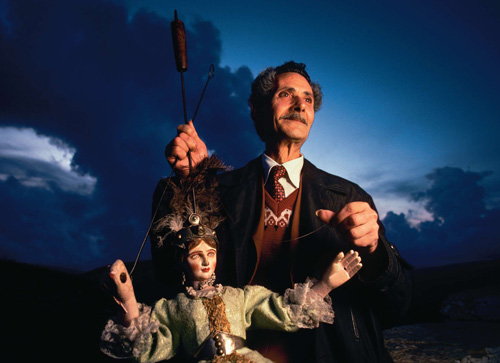
“The hardest thing about lighting is NOT lighting. We’re talking control of light here-- lighting THIS, but not THAT.”
The hardest thing about lighting is not lighting. We’re talking control of light here—lighting this, but not lighting that. The problem is that light from a strobe likes to party—it pretty much goes everywhere—and it’s your job as photographer to be the cops, shut down the party, close the bar, and tell everybody to follow you.
I showed up to photograph Dr. Jeremy Nathans, whose work centered on color and the human brain. I had a couple of flashes with me, cameras, and a tripod.
Given Nathans’ work, he had a bunch of color gels. I covered the lenses on two Kodak carousel projectors with swatches of primary colors and asked him to put on a white lab coat. I tipped the projectors so that the primaries crossed and became the complement on the white coat.
Now all this clever color would go bye-bye if I just set off a flash in something like an umbrella. Hello washed out, dramaless, crappy picture that won’t get published!
I was always good with construction paper and tape back in grammar school, and things haven’t changed much. I took one small Nikon SB flash and taped a tight honeycomb spot grid[1] over it. Then I took some gaffer’s tape and cut the grid even further, making a small, controlled opening for the light. I positioned the flash directly in front of his face (the flash was clamped to a ceiling tile), with a quarter-cut CTO[2] gel on the flash to make the light a little warmer and add a little drama.
[1] Honeycomb Spot Grid: A circular metal grid (that looks like a honeycomb) that goes over your strobe head and limits the spread of the light.
[2] CTO: Color Temperature Orange. It’s an amber gel, available in various intensities, that pushes daylight towards the warm (tungsten) end of the color scale. A quarter-cut means you get one-quarter the warmth of the full gel.
It ain’t pretty, but it works.
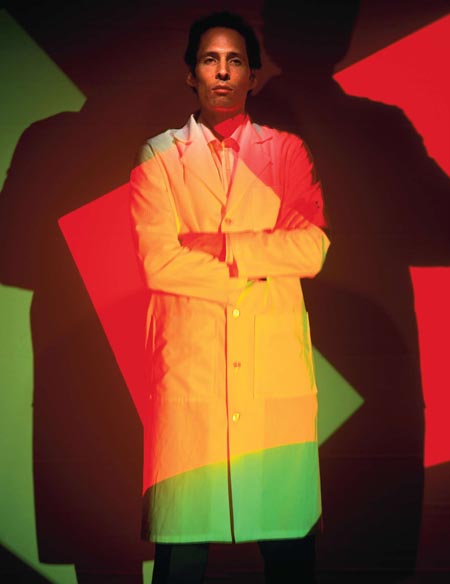
Dr. Jeremy Nathans
“You know the standard rule of photography that states you shouldn’t shoot people with a wide-angle lens? It’s a rule meant to be broken.”
Ever notice when you put a wide-angle lens to your eye, and it looks great, and you think you’ve got everything in the picture, you look at it later and you’ve got too much of everything in the picture, and the crucial elements are teeny tiny in the back of the frame where you can barely see ‘em? Tom Kennedy, my editor at the Geographic, always told me to: “Push the wide-angle lens—go wide, get tight, fill the frame.” What he means is that consistently shooting pictures from a middle distance, at eye level, is a one-way ticket to boring pictures.
You can push a wide-angle lens very close to someone’s face and still see the street behind them—there’s plenty of context. You know the standard rule of photography that states you shouldn’t shoot people with a wide-angle lens? It’s a rule meant to be broken. Open any magazine and flip though the environmental portraits—you’ll see a horizontal, wide-angle lens used very close to the subject again and again.
Here’s an example: at a workshop once, I had a lovely lady who was assigned to do a story on a boat captain. She was terrified of shooting people, and kept coming in with these wide-angle pictures that showed the whole boat with the captain doing something interesting that you couldn’t see because he was the size of a pea at the back of the boat. After three days of this, I took her camera, walked up to her, extended my arm, and placed my hand on her shoulder. I said, “Today, you will take this camera and this wide-angle lens, and you will be no further than this (meaning the length of my arm) from your subject, all day.” Her pictures improved dramatically.
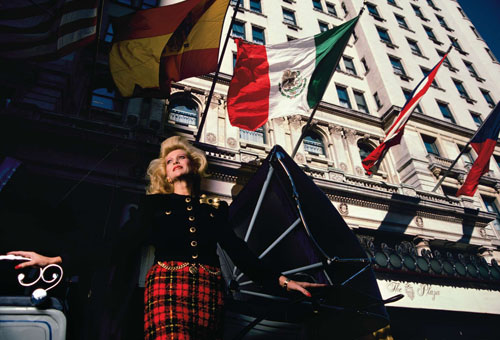
Ivana Trump
We were photographing Ivana Trump back in her “The Donald” days, when she was running the historic Plaza Hotel in NYC. I had the bright idea of photographing her atop one of the horse-drawn carriages. It was February.
I shot a few frames and she looked over at me and said, “Dahhhling, don’t keep me out here too long. I don’t want to catch ammonia!” Subjects sometimes say some pretty nutty things, and my advice is always just to smile and nod, and keep shooting.
I didn’t bring her out in the freezing cold for no reason. Nor was the horse-drawn carriage an accident. In New York, the historic façade of the Plaza is instantly recognizable, and that hotel and the Central Park horse buggies go together like pastrami and rye, Frazier and Reed, Empire and Chrysler. They are inseparable, quite unlike Ivana and the Donald ultimately proved to be.
Like most celeb shoots, especially those where the famous subject is shivering, it was over in minutes and consumed less than a roll of film. She’s standing in shadow and the building is in hot light. I put up a mid-sized umbrella on camera left, bumped her exposure up by at least three stops to bring her in register with the sunlight up above her, and blasted away.
Coulda kicked myself later, though. Shoulda used a softbox. The umbrella is lighting her okay, but also heating up the shiny surface of the carriage on the left of the frame. A more directional light from a softbox would have cured this a bit, as I could have then feathered it off to the right. (Feathering is basically rotating the light source right or left to direct the bulk of the light away from a potential hot spot. Nowhere near as effective a technique with an umbrella, ‘cause an umbrella scatters light much more broadly than a softbox.) A flag, cutter, or GOBO would have helped, too. Or a winter jacket. Or a newspaper. Stick just about anything between the strobe and a shiny surface and it will help take some of the heat out of it.
I didn’t do it, of course, I was moving too fast. I didn’t want to catch ammonia.
Smile and nod.
“Stick just about anything between the strobe and a shiny surface and it will help take some of the heat out of it.”
“If you want to be a better photographer, stand in front of more interesting stuff.”
My friend and colleague, Jim Richardson at National Geographic, has simple advice for anyone who wants to become a better photographer: “If you want to be a better photographer, stand in front of more interesting stuff.“
So, what could be more interesting than a bunch of Munchkins?
You know, the original Munchkins. Somehow Life magazine got access to the last living Munchkins. The magazine had no idea how to shoot them. So I put ‘em in flower pots. My editor told me I was a sick bastard, but hey, in The Wizard of Oz they pop right outta the garden, so I figured, why not?
I hauled in 300 pounds of topsoil to the rental studio. The studio people were reeeeeally pissed at me. Not only did it stink, topsoil got everywhere—like the cracks in the wood floor...the white wood floor. We were up until midnight with vacuums trying to get it out.
So the Munchkins pull up in this limousine. I meet them and we ride up to the seventh floor, alone. We get into the elevator and the door closes. I look around and, honestly, it was kinda creepy. I was trapped in a confined space with a bunch of Munchkins. I mean, I got an active imagination, and I started thinkin’ about them turnin’ on me, their little faces gettin’ all mean-like and their lollipop-guild voices saying, “Okay, let’s have the wallet, sumbitch.”

“If you catch the light just right, you can throw it a long way.”
Think of it as volley and serve with the sun. Find the right angle and you can just smoke a return back the other way.
You don’t need much to do this. There’s all sorts of springy, twisty, bendy, collapsible-type fill surfaces out there that compact real well and stuff in your bag. Lastolite makes a thing called a TriGrip reflector that gives you a handle to hold it with one hand while you shoot with the other.
But a piece of white cardboard will do. So will a bed sheet. Or a table cloth. Or a bunch of pieces of Xerox paper Scotch-taped together.
Just make the catch.
It’s also advisable not to have your own gear in the picture. Some editors will get upset about that. In this instance, you can tell I’m using a fill card, ‘cause it’s poking into the left side of the frame. Oops.
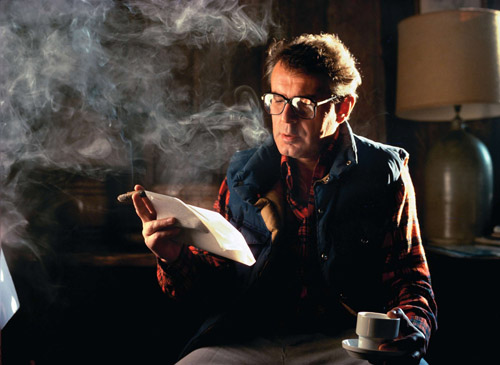
Milos Forman
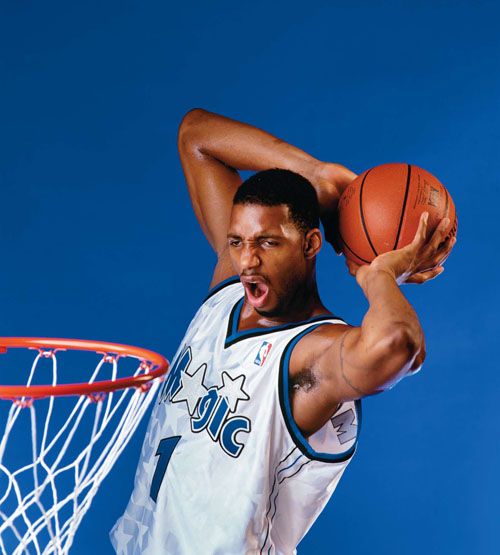
Tracy McGrady
I was assigned to shoot Tracy McGrady, with the Orlando Magic, for a cover of a kids’ sports magazine. We had it all set up for a simulated action shot on a seamless. I was working for a very enthusiastic, very young picture editor. I loaded a back and turned around. Tracy was gone.
“What’s up?” I asked the picture editor.
“Oh, he’s just going into the locker room. He said he’d come right back and then we could go to his house!” he said excitedly.
I looked at the ground, shaking my head. “He ain’t comin’ back.”
“No, really, he said we could come to his house, he’ll be back....”
Both of us stared in the direction of the locker room where our star disappeared. I only had a few frames and I knew Tracy was already halfway to his house in a gated community outside Orlando. Gone. Shoot was over. Cover never ran.
Young athletes. Stick with ‘em. Always remember they’d rather be playing Halo.
I was in this glitzy hall of mirrors that was the main office of cosmetics maven Georgette Klinger, shooting a business feature for Forbes magazine, and there was a spiral staircase where we couldn’t use a softbox or an umbrella because the mirrors would have picked it up. Luckily, I had a bounce card (a 3×4′ piece of white cardboard) with me and I had my assistant stand just out of the reflection in the mirrors, where he held a small flash and bounced it off the card, which filled her just enough. It ain’t great light, but sometimes “just enough” is plenty.
In tough situations like this, I take inspiration from one of my photo heroes, Jim Stanfield, who tells a story about being on assignment for National Geographic, shooting an ornately dressed bride in a cavern of a church, with only one flash in his bag. He really had nothing to bounce off of (Jim being Jim, he knew that straight-on flash equals no picture). His solution: he called the groom over and had him open his suit jacket, so he could bounce his flash off the groom’s white shirt. He got a terrific frame.
This ain’t rocket science.
Jim, by the way, could outshoot most of us with one eye shut and a bug in the other. If you want to know how to be an all-purpose, can-do-anything assignment photographer, study his work.
“Jim being Jim, he knew straight-on flash equals no picture. He called the groom over and had him open his suit jacket.”
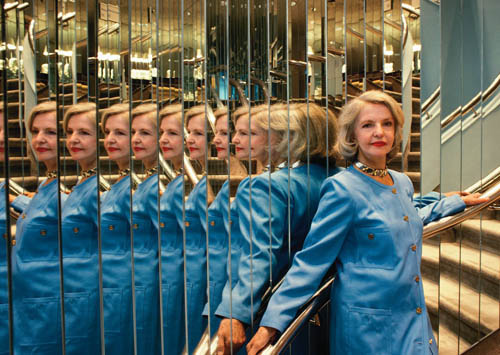
Georgette Klinger
“There was a big window and a little window. In my photographer’s brain, that translated into Main light, Fill light.”
There is nothing like the light in an Irish bar.
On the east coast of Ireland, the soft window light makes everyplace you go a studio. Legendary Irish writer Frank McCourt was sitting there and I noticed there was a big window and a little window. In my photographer’s brain, that translated into main light, fill light.
I posed Frank against a dark wall with the windows on either side. It took about a minute to shoot at ISO 400 and we’ve made 24×30″ prints of this frame.
Stuff like this happens and it convinces me all over again of two things:
- This digital stuff really works.
- Autofocus is really handy when you’ve had three pints of Guinness.

Frank McCourt
“Straight flash is Disaster Light.”
Straight flash is disaster light. Use it at 3:00 a.m., with bodies on the highway, and nothing to bounce off.
Jerry Seinfeld has a funny routine about guys who are desperately trying to meet girls but can’t figure out how. He talks about the guy who sits in his car and honks his horn at women. As he very rightly points out, “This is a man who has run out of ideas.”
As photographers, when we use straight flash, we’re that guy.
We’re in the cavern of a casino—nothing to bounce light off of—straight flash was the only way to go. In this case, the picture sucks, but the personalities saved it. And believe it or not, this picture got published in Newsweek. The mantra of editoral photographers is “get the shot”—even if you know it’s going to suck, when you have an array of personalities like this, you have to put the camera to your eye.
That being said, any light that originates at the camera is de facto unflattering—you’re literally throwing light at your subject. You’re not making a picture, you’re making a copy. It’s a game of inches, even if I can only get the flash off the camera by a few inches (to the left or right of my camera), I know I improved the quality of my light. I always tell my students: when you use straight flash, you turn your camera into a Xerox machine.
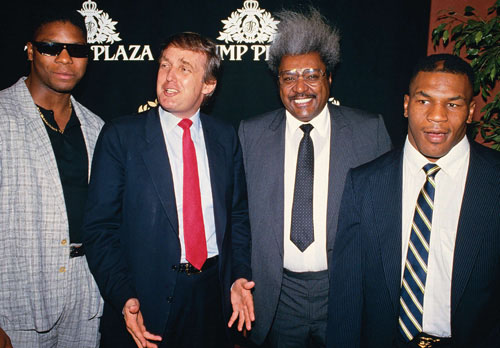
Tyrell Biggs, Donald Trump, Don King, Mike Tyson
“Pray for bad weather. It makes for GOOD pictures.”
When my students go out and see a cloudy day and sigh, I tell them, “I love this weather.” When there’s clouds, there’s soft light, and that means there’s texture and shape in the sky—not just a bald blue. This lack of light gives you enormous control, if you’re using flash.
On a bright, cloudless day, it’s close to impossible to overpower the sun. Put a rack of clouds up there and you’ve got an instant softbox in the sky, and then by introducing your own light, you can easily use the cloud light as either a main or a fill light.
Things like raindrops on windows are a wonderful thing to shoot—and there’s never been a better time to shoot on a rainy day, thanks to new camera technology (as some bodies are now sealed against moisture) and a whole range of camera rain covers from companies like Kata.
“You are not going to be in the room when people look at your pictures. Your picture has to speak for itself.”
I always tell my students, and I really try and hammer the point home, that you are not going to be in the room when people look at your pictures. The picture has to speak for itself. No matter what your experience of that day, no matter what you went through to get that photo, it doesn’t make a bit of difference to someone who’s looking at that photo, unless the photo carries the experience.
For a shot to really work, it’s got to be successful pictorially, informationally, and emotionally. Face it, we’re emotional creatures—we come back with these pictures we took, and we’re like the six-year-old in kindergarten running up to the teacher with our scribbling and saying, “Look what I did! Look what I did!” Just because we’re excited about it, doesn’t mean it’s not scribbling.
So when you’re in the field—think like a photo editor. The best quality a photo editor brings to the table is dispassion. It sounds cruel, but they don’t give a rat’s @$$ if you had a bad day, or the boat capsized, or people were mean to you. All they care about is the picture: does it speak or does it not? If you think like a photo editor, your pictures will get better because you won’t go easy on yourself. You have to be your own toughest critic.
This portrait of Leonard Bernstein composing at the piano has always been one of my favorites. No explanations are needed. The room feels like music.

Leonard Bernstein
There have been times in the field when I don’t remember breathing. This girl was blinded by her boyfriend, who shot her in the head twice. She is “seeing” her first horse.
This moment can’t be orchestrated, won’t come again, and reminds you of why you are a photographer. It’s never been published.
Sometimes I am asked why a white horse has a yellow nose. The window light is bouncing off bales of hay. Light picks up the color of what it hits.
I shot this with a Leica, because in an emotional, quiet scene like this, you don’t want the sound of a motor drive to destroy the atmosphere or spook the horse.
“Light picks up the color of what it hits.”
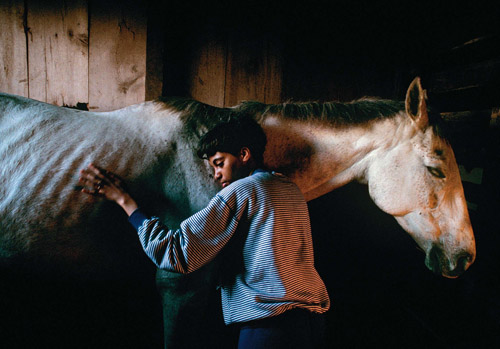
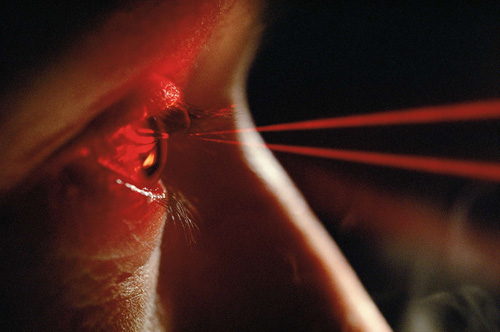
“I wanted to show everybody my prize tray of slides. ‘Wanna see my sight tray?’ became the extent of my conversation. Didn’t matter who you were. The poor FedEx guy would show up with a package. ‘Wanna see my sight tray?’”
Ever notice how a conversation with a photographer goes something like, “That’s enough about me, let’s talk about what you think of my work!”
We’re mildly self-involved. Especially after you’ve worked on a National Geographic story called “Sense of Sight” for the better part of a year, and it gets the cover and runs 40 pages. I was very proud of it. I wanted to show everybody my prize tray of slides. “Wanna see my sight tray?” became the extent of my conversation. Didn’t matter who you were. The poor FedEx guy would show up with a package. “Wanna see my sight tray?”
After that story, I put my feet up and waited for the phone to ring. And waited. And waited some more. Never happened. I had spent so long and had dived so deep into the story, I had to go out and pound the pavement, reminding people I existed.
It was a long haul before I got any work again. Bills were mounting. Couldn’t pay ‘em. It was bad. Not a happy household. Tense, in a word. I was on the phone with American Express, telling them they‘d get their money real soon. My now ex-wife called out from the kitchen, “Why don’t you show them your sight tray!”
Lots of lessons learned. Including the wherefores of a shot like this, which is basically spit, glue, and a whole bunch of luck.
“Keep your camera near your Eye.”
Steve Martin and I were on the beach and we were both like pilots who had lost airspeed, altitude, and ideas all at once. I knew the shoot was just about over.
“This year has gone really well for you,” I said, reaching for anything. “Is there any way you can show me that?”
“Yeeaahhhh, but you know, when you physicalize an emotion like that, you tend to appear self-obsessed,” he replied, grimacing.
A voice in my head was shrieking, yeah, that’s the deal, you are self-obsessed!
And then he gave it to me, mostly because he thought I wasn’t ready. My camera was off my eye, down at my chin, but pointed at him. He gave it to me for a split-second, which was actually pretty generous of him, ’cause he didn’t want to do it. I squeezed off one frame without looking through the lens.
The two major pieces of any picture story are your opener and your closer. I just got the closer.
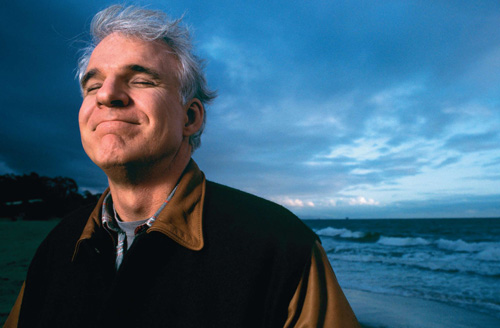
Steve Martin
“I was Photographing this poor guy and his D.I. came up to him and started screaming, ‘Oh good, they’re gonna put you on the cover of Whiner magazine!’”
When stuff like this happens, man, you feel bad for the guy. You just have to remember that you are there doing your job, and he is doing his, and this is Navy SEAL Hell Week and all this misery would be going on whether you are there with your camera or not.
Speaking of misery, that is the name of the log these guys are hoisting. The boat crews for the SEALs routinely work out with and carry around the equivalent of a telephone pole. When they screw up, they get to meet a very special telephone pole, this 350-lb. pup nicknamed “Misery.”
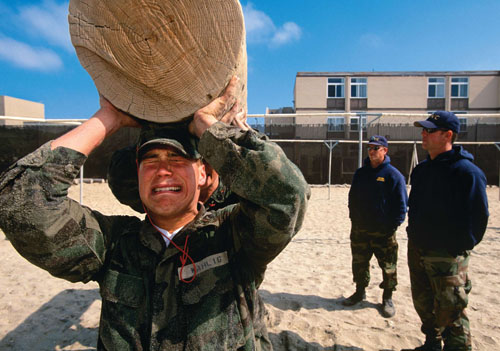
“In this image-crazed world of ours, you need your pictures to shout.”
Thinking up a shot like this, I feel like a carnival barker. Ozzie Smith! The Wizard of Oz! Looks like he plays shortstop from five different positions at once! See the bearded lady and the amazing fire-eating contortionist!
It makes sense, actually. In this image-crazed world of ours, you need your pictures to shout.
So how do you get a cool picture of this magical ballplayer? Mirrors!
Oh, boy. Mirrors are great, but they are fragile, heavy, expensive, and highly reflective. I always remember stuff like that too late.
We got them out to the infield okay. Got them tweaked and torqued, polished and cleaned, sighted and sandbagged. Ozzie was not in the picture, he was standing right next to the camera. He was lit with a strobe on a huge movie boom, flying overhead of the whole scene, just out of frame and looking back at the camera. I controlled the spill of light with a tight honeycomb spot grid[1]. Otherwise, it would have been flare city back at the lens.
[1] Honeycomb Spot Grid: A circular metal grid (that looks like a honeycomb) that goes over your strobe head and limits the spread of the light.
Dusk was coming and I noticed something. Our white elephant of a grip truck was reflected in every mirror. A not-so-minor detail I managed to overlook while setting up.
Couldn’t move the truck—all the power lines were running out of it. Okay, white reveals, black conceals! Quick race to the nearest fabric store. “Hi, I need to buy every yard of black material you have in this place!” Retailers love desperate photographers.

Ozzie Smith
